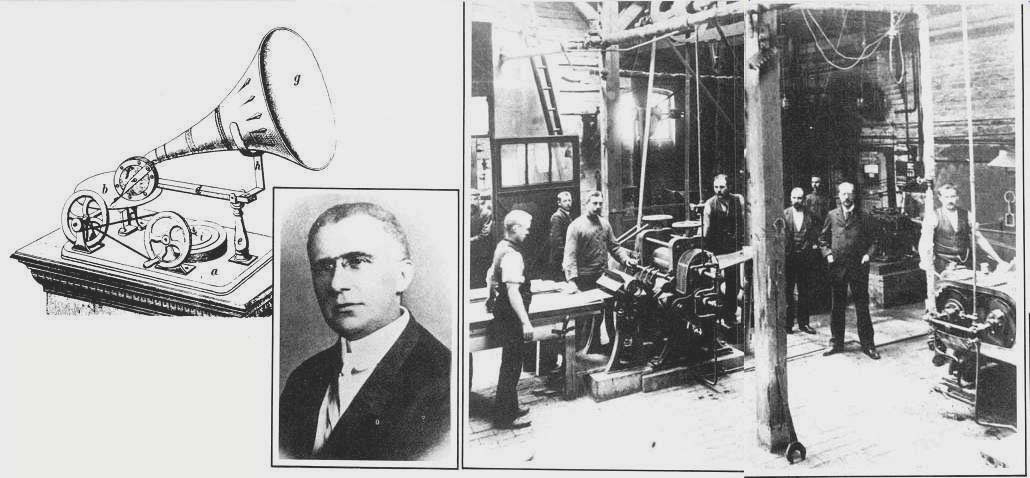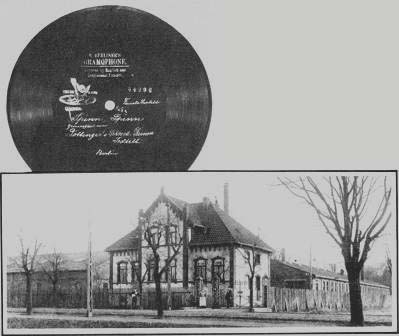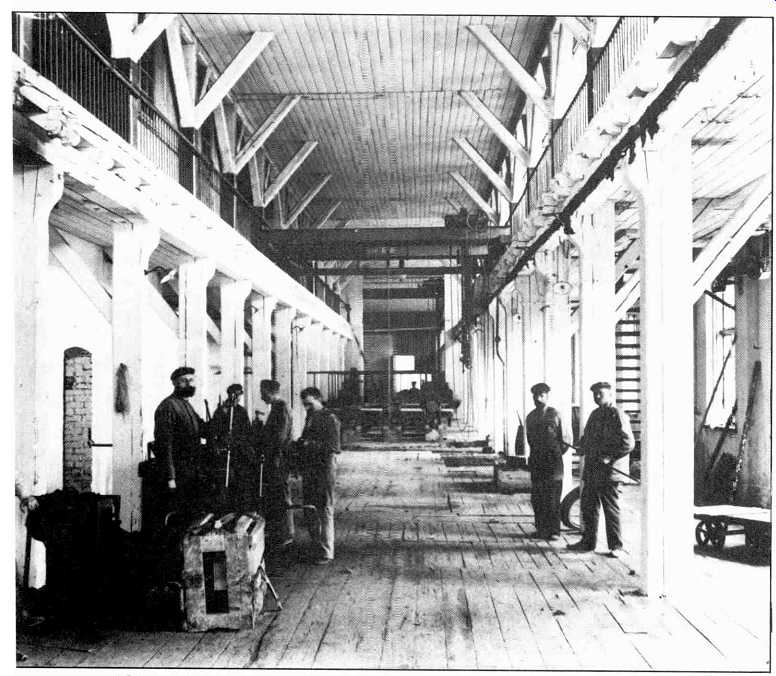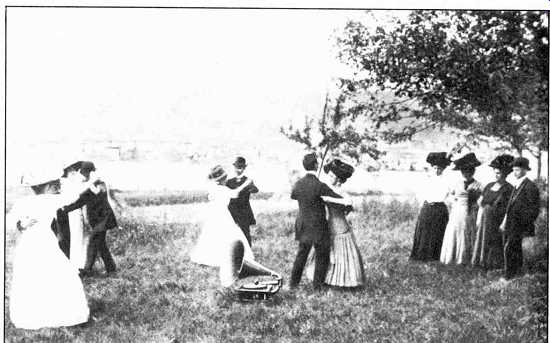
above: The sketch above accompanied the 1887 patent application by Emil
Berliner, right. DGG's birthplace was a corner of a telephone factory, show
in center. Joseph Berliner is second from the right.
by Robert E. Brockway [President, Polygram Corp.]
THE RECENT CELEBRATION of the 75th anniversary of the founding of DGG, Deutsche Grammophon Gesellschaft, recalls that the man who founded the record company, Emil Berliner, had also invented the first flat recording disc ten years earlier.
Unlike Columbus who made a flat world round, Berliner believed Edison's cylinder was the wrong approach and flattened it, whereon hangs the re cording industry.
The flat disc was not Berliner's first contribution to communications, although it was his most significant. Earlier, in 1876, Berliner saw Alexander Graham Bell's telephone displayed at the Philadelphia World's Fair. Berliner knew a good idea when he saw one, but Bell's device lacked a vital ingredient. It had no way to pass sound along adequately.
By then Berliner had been in the U.S. six years, after arriving from Hanover, Germany to become a dry goods store clerk in Washington, D.C. He quit before long to study acoustics and electricity at Cooper Union, New York. Setting up a lab oratory of sorts in his room at a boardinghouse, he solved Bell's problem by inventing a microphone. He patented it and sold it to Bell for $75,000.
This enabled Bell to launch its telephone business in competition with Western Union, which had come up with a carbon transmitter invented by Edison. By the standards of the time, this left Berliner a well-to-do young man with most of his life still ahead of him.
Berliner and Edison ideas collided again in the development of the phonograph. The word phonograph was apparently Edison's, although some controversy still exists on that subject. There's no argument over who thought up the word gramophone.
Berliner coined it to describe the invention for which he applied for a patent on September 26, 1887, some ten years after the appearance of Edison's phonograph.
Near the end of December 1877, Edison had descended on the office of Scientific American with his cylinder-playing phonograph. The magazine reported: "Mr. Thomas A. Edison recently came into this office, placed a little machine on our desk, turned a crank, and the machine inquired as to our health, asked how we liked the phonograph. informed us that it was very well, and bid us a cordial good night." Edison's gadget was simple to the point of crudity. The cylinder wore out after a few plays. It squawked indistinctly, but skeptics acknowledged that Edison's tin-foil cylinders really did record sound and play it back.

--------- Gramophone discs had grooves on one side only, measured 17
cm (seven inches) across and the titles and artists' names were scratched
on by hand. Emil Berliner's "trademarks" including the cherub inscribing
a disc, were stamped on. In 1903, DGG moved out of the telephone factory
into this building in the Celler Chaussee (later Podbielski Strasse).
Ten years later, Berliner began the uphill battle to overcome the widely acclaimed wax cylinder's lead. The matter was more or less settled in the first decade of the new century. It might have been harder if Edison hadn't taken time out to invent the electric light bulb and if he hadn't been convinced from the beginning that the phonograph was not destined to entertain but to be a business machine.
This view was shared by the Bell Tainter Graphophone, which also foundered as an entertainment vehicle under the impact of the gramophone. All their early models were crude. Berliner's gramophone came with instructions for use which ran only half a dozen paragraphs. But additional "special instructions" ran several pages. Here's how simple the state of the art was as late as 1898 when Berliner's Deutsche Grammophon Gesellschaft began making its first players and discs. DGG characterized the advantages of the gramophone over the others this way:
"With Tainter's Graphophone, only the listening tubes can be used as otherwise nothing can be understood. This is mostly also the case with Edison's Phono graphs. With the Gramophone, too, the reproduction of sounds is clearer through the tubes than through the horn and these can also be used by two people at the same time if each puts one listening piece in one ear and holds the other ear shut with a hand."
The special instructions with the DGG gramophone found it necessary to add: "In order to understand the speech of the Gramophone properly, the ear must first accustom itself to it, as is of course also the case with the Telephone, but this will happen in a short time."
Then there was the hand crank the listener presumably turned with his third hand while he held one tube to one ear and clamped his second hand over the other ear as earlier instructed. Plainly, the hand crank required careful handling: "We would like to emphasize . . . that regular turning is an absolute necessity for the veracity and understanding of the sounds and words. Irregular turning gives irregular and therefore un-understandable reproduction!" (The exclamation point is in the instructions.)
Cranking by hand was reduced to a time/energy formula: " . . . turn the drive wheel to the right at a speed of about 150 turns per minute and the apparatus will function." Timing the count must surely have distracted the user's attention from what he was playing.

--------1898--DGG's first year with only a few machines and a handful
of workers.

-----------Joseph Berliner

--------This 1911 photo shows society ladies and gentlemen waltzing
to the strains of the Gramophone on the banks of the Rhine.
The gramophone came with a supply of needles and this severe warning: "Care should be taken that when changing the needles . . . these are screwed in straight, that is, vertically and in a straight line with the sound box, and above all tightly." It is further advised: "A needle which has worn down through long use and has been taken out must never be replaced as this, worn on one side, would cut the grooves of the plate with its sharpness and bent point." Extra needles would be furnished on demand, the 1898 buyer was assured, and: "In emergencies, one should use broken-off darning needles with good rounded points." All this reflects no discredit on the early models which broke the ground for today's far-out equipment bringing higher fidelity to listeners than could have been dreamed of in 1898.
Berliner had begun experimenting with a plate glass disc surfaced with lampblack. Whether he hit on this himself or had heard of a scientific paper by Charles Cros, an obscure figure who in December 1877 contributed the idea to the French Academie des Sciences, can't be said. But Berliner carried out what Cros merely theorized.
He set his lampblack glass disc on a turntable and applied a stylus to it as it turned. Sound waves fed to the stylus produced a tracing in the lamp black which varied with the vibrations.
Berliner varnished his tracing to pre serve it and had it photoengraved in metal. The end product played back, proving to Berliner that he was on his way towards building a better mousetrap than Edison's.
He applied for a patent, aware that lampblack wasn't the answer and that slow, costly photoengraving had to be replaced by something cheaper and faster.
Instead of turning from his brain child to invent something else, as Edison had, Berliner continued to cut and try for better records. He soon turned to acid to engrave his master by chemical action. Eventually he tried film coating over zinc. When this laminate was inscribed by a stylus and dipped, the acid action proved effective but not excessive, creating even grooves which, in turn, yielded to the playing needle better sound reproduction than lamp black.
Berliner was ready for the first demonstration of the flat disc. On May 16, 1888, he presented some samples at the Franklin Institute in Philadelphia. It is remarkable that, at a time when Edison and Tainter were predicting success of their inventions as dictating machines, Berliner's talk-up at Philadelphia heralded mass distribution of recorded music, reproduction of un limited numbers of discs from a single master, and the coming of artist royalties. Those prognostications proved more impressive than the demonstration itself. One reaction likened the sound of the improved Berliner disc to the braying of an ass. The playing machine was labeled not very impressive.
Not very discouraged, Berliner went to work to fulfill his prophecy of unlimited copies struck from a master. Before long he came up with the process of creating a master metal negative from the acid-dipped original, using the negative to press multiple copies. Once Berliner perfected his original-to-negative-to-positive process, the stage was set for the growth of the multi billion dollar record industry. Every thing that has followed, right up to today's injection molding record pressing methodology, is refinement on the Berliner concept.
By 1893 Berliner was using hard rubber discs, had developed a reason ably reliable pressing process, and felt he was ready to go into business. He formed the United States Gramophone Company on Pennsylvania Avenue in Washington, D.C.
Before long the company was offering one-sided seven-inch records with two minutes of playing time, priced at 50¢ a record, $5.00 a dozen, featuring mostly obscure local talent.
The gramophone itself came either electrically powered or hand cranked. The latter sold for $12. In 1894 it was the cheapest on the market. It was available to buy, but almost nobody had one and it attracted very little attention. By late the following year, investors were found and the final struggle between disc and cylinder began. It ended in the early 1900's with the flat disc in firm control and the cylinder destined to retreat to attics and museums.
It wasn't until autumn 1898, some eleven years after he patented the flat disc, that Emil Berliner and his brother Joseph founded Deutsche Grammophon Gesellschaft, whose jubilee was just observed. At the same time, planning to concentrate his own efforts on European production centered in Germany, Berliner sent his American associate William Barry Owen to establish in England The Gramophone Company which today is known as EMI.
Berliner went on to invent an engine for airplanes that allowed lower in flight speeds, leading to the helicopter years later. Research that Berliner conducted into improved methods for sterilizing milk cut infant mortality. In 1922 he made a gift to the City of Hanover of $200 for acoustics improvement in the local assembly hall. Three years later he patented an acoustic tile that did the job. History doesn't tell us if they awarded him the $200. But his invention made possible better sound distribution in churches and other large areas.
The name Deutsche Grammophon lives on in two ways. First, it continues as the world-famous DG Yellow Label. And although Polydor International has become the name of the worldwide music business that started as DGG, the German subsidiary of Polydor is still called Deutsche Grammophon Gesellschaft. Here in America, the group is represented by Polygram Corporation. Firms in 18 countries carry the Polydor name. The company's pop and classical repertoire is marketed throughout the world. Today, factories in 21 countries produce Polydor tapes and records.
Emil Berliner died in Washington, D.C. in 1929. He had made possible not only the DG and Polydor products, but the entire spectrum of recorded opera, symphony and popular music enjoyed by millions. It is not surprising that observances have been taking place not only in Hanover, where the company still has a production center, but in Hamburg, home of Polydor International, and at Polydor subsidiaries everywhere.
(adapted from Audio magazine, Jun. 1974)
Also see:
iar--Classroom to Studio (Aug. 1974)
= = = =